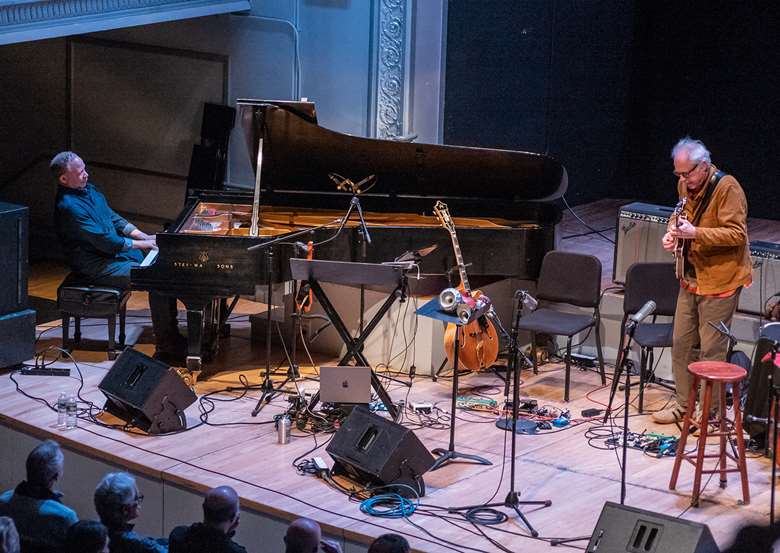Bill Frisell, Mary Halvorson and John Zorn among starry Derek Bailey tribute at Brooklyn's Roulette theatre
Andrey Henkin
Tuesday, January 31, 2023
A stunning and varied line-up performed over three nights to salute the music and life of the improvising guitar genius Derek Bailey

Derek Bailey (1930 – 2005) was among the purest adherents of non-idiomatic free improvisation during his lifetime, whether it be collaborations with Anthony Braxton, The Ruins or whatever was on the radio, seminal book Improvisation: Its Nature and Practice or his famed Company nights of the '70s-90s, bringing together international casts for intense spontaneous creation. Alto saxophonist John Zorn, himself a participant in the Company events, celebrated that legacy with three nights at Brooklyn's Roulette (19-21 January).
Twenty-two players took part. Zorn and guitarist Bill Frisell were the stalwarts, appearing on all three nights. The demographic range was wide, septuagenarians Frisell, trombonist/Roulette co-founder Jim Staley, bass trombonist David Taylor and violinist Laurie Anderson alongside 20- to 30-somethings like alto saxophonist Immanuel Wilkins, guitarist Wendy Eisenberg, bassist Brandon López and drummer Kate Gentile, and stretched to musicians from Japan (electronics player Ikue Mori) and Cuba (drummer Francisco Mela). The format was also novel. Each evening was a dozen (13 on the second night) improvisations for no more than 68 minutes total, including lineup changes.
The longest piece was six minutes, a nightmarish video game soundtrack from Anderson, López and pianist Craig Taborn on the first night. Anyone with experience in free improv settings has often sat through an hour of a single group to pan only a few minutes of gold. Given the constraints, players had to be especially focused so as not to take away time from others while still trying to craft something meaningful in an almost impossibly short moment. One particular benefit of this was that those playing next – gathered on the side of the stage and often put together on the spot by Zorn or themselves – were aware of what came right before, so their own improvisations were not only self-contained but, to a point, a response to what preceded them.

Dave Taylor, Jim Staley and John Zorn in action - photo by Matt Mehlan
Taken as a whole, the tribute to Bailey's spirit was a success, with most players keeping agendas to a minimum and subsuming individual vocabularies into the greater whole. To rank the performances would be anathema to Bailey and his ideology but certain things stood out.
It was refreshing to hear players like Frisell or pianist Arturo O'Farrill in freer environments than their usual Americana and Latin jazz settings. Numerous slices drawn from the New York City jazz deli counter were stacked into delicious first-time sandwiches: the Dutch-style semi-comic abstraction of Taylor, guitarist Mary Halvorson and pianist Brian Marsella; free-country from Anderson, Zorn and Gentile; evocation of a raft of angry ducks by Zorn and fellow altos Matana Roberts and Caroline Davis; the palpable tension pulled from the strings of Frisell and López; the evolution-chart-in-reverse that was the trio of Frisell, Halvorson and Eisenberg; and the unusual combination of guitar (Frisell) and santur (Amir ElSaffar, who also appeared elsewhere on trumpet).
Though not the intent, three groupings deserve revisiting in longer-form excursions. A new type of percussion trio was assembled from Marsella, Gentile and vibraphonist Patricia Brennan. Gentile offered punky energy for the pummeling of Marsella and Brennan, Pollack-like action painting as applied to music. There was a brief dip into serenity but it was quickly discarded for more fire. This was a great example of how five minutes could seem like much more. Davis and bassist Henry Fraser sounded less like music and more like a ghost ship drifting endlessly along a still ocean, breath and bow becoming dead wind and tolling bells, Davis sweeping her bell across the microphone for extra depth. And O'Farrill and bassist Jorge Roeder (hailing from Mexico and Peru, respectively) provided the most unusual segment with a repeated figure of simple beauty, demure in its ambition, creating consonance when most others favored something more chaotic.
And while musicians like Frisell, Halvorson, Zorn or Taborn were known quantities to the audiences, two players at opposite ends of the career spectrum made, one hopes, strong impressions on the uninitiated: Taylor, with hundreds of credits since the '70s with figures as disparate as Duke Ellington and Mostly Other People Do The Killing, was expressive, vocalic and cinematic; and Brennan, one of a few highly compelling vibraphone players of the last several years, pushed the instrument far past its inherent limitations.